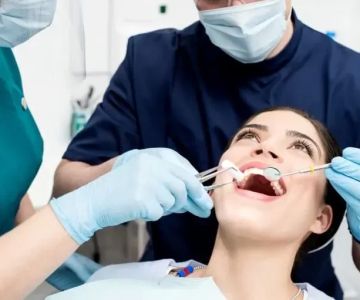Introduction to Emergency Dentistry
In the realm of oral health, emergencies can strike when least expected, necessitating immediate attention to prevent further complications. The concept of emergency dentistry primarily revolves around providing timely care for unexpected dental issues that could escalate into severe conditions if left untreated. In the United States, access to emergency dental services is crucial, as dental emergencies can range from excruciating toothaches to broken teeth resulting from accidents.
As more Americans recognize the importance of oral health, understanding the scope of emergency dentistry becomes vital. Whether it's a sudden tooth fracture, an unbearable toothache, or a dental injury from a sporting event, knowing when and where to seek urgent care can significantly impact long-term dental health outcomes. At Dentistry Toothtruth, we are committed to providing reliable insights and timely interventions for all dental emergencies.
The prevalence of dental emergencies highlights the necessity for public awareness and preparedness. With the rapidly evolving healthcare landscape in the United States, understanding how to access emergency dental care, what conditions require urgent attention, and the role of dentists in mitigating risks is more pertinent than ever. This article aims to delve into these aspects, providing a comprehensive guide that equips readers with essential knowledge to handle dental emergencies effectively.
Recognizing Dental Emergencies
Not every toothache warrants a trip to the emergency dentist, but certain situations clearly indicate the need for immediate care. Dental emergencies often present as severe pain, bleeding, or trauma that affects your oral health and requires immediate intervention to preserve the tooth or alleviate pain. Common examples include sudden, intense toothaches often signaling an infection or abscess, knocked-out teeth needing prompt action to increase the chance of successful reinsertion, and broken or cracked teeth exposing the pulp.
Other critical conditions include lost fillings or crowns, which can leave the sensitive areas of teeth vulnerable, and soft tissue injuries like cuts on the tongue, cheeks, or gums. Being able to differentiate between emergent and non-emergent issues is crucial. Non-emergency scenarios can generally wait for regular office hours, although they should still be addressed timely to prevent potential complications.
According to the American Dental Association, understanding the signs of potential emergencies can save patients from unnecessary pain and prevent minor problems from escalating. To facilitate proper identification, having a list of typical dental emergencies and their symptoms readily available is beneficial. Patients are encouraged to contact their dental professionals to verify the urgency of their situations and to receive guidance on necessary actions to take prior to arriving at the clinic.
Immediate Actions for Sudden Toothache
Toothaches often catch individuals off guard, causing immense discomfort and potentially signaling a serious underlying issue. Immediate steps taken at home can offer temporary relief while preparing to visit an emergency dentist. If you experience a sudden toothache, start by gently rinsing your mouth with warm water to cleanse the area. Next, use dental floss to dislodge any trapped food particles, which might be exacerbating the discomfort.
Over-the-counter pain relief medication can be used judiciously, but placing aspirin or any painkiller directly against the gum is not recommended, as this can burn the tissue. Applying a cold compress to the outside of the cheek can help reduce swelling, commonly associated with toothaches. However, it's important not to apply ice directly to the tooth or gum, as this can potentially cause further damage.
Preventive care plays a vital role in mitigating the risk of toothaches. Regular visits to your dentist can help detect early signs of tooth decay or gum disease, preventing any drastic occurrences. At Dentistry Toothtruth, our expert team advises on strategies to maintain optimal dental hygiene, effectively reducing instances of urgent dental visits stemming from preventable ailments.
Handling a Knocked-Out Tooth
A knocked-out tooth represents one of the most alarming dental emergencies. Immediate action and proper handling can dictate the fate of the tooth. If you or someone else experiences this crisis, it’s crucial to handle the tooth by the crown, avoiding contact with the root to reduce the risk of damaging any ligaments or remaining tissue. Rinse the tooth gently with water if dirty but do not scrub or use any cleaning agents.
Attempt to reinsert the tooth into the socket, ensuring it is facing the correct direction. If reinsertion isn't possible, place the tooth in a container of milk or a specialized tooth-preservation solution. These liquids mimic the natural environment of the mouth, preserving the vitality of the root longer than water. Timing is critical, as reinserting a tooth within an hour increases the chances of successful reattachment.
It's essential to seek dental attention immediately after securing the tooth. At Dentistry Toothtruth, our emergency services are geared to handle such urgent cases with precision and care, aiming to restore dental integrity and aesthetics efficiently. Understanding the steps to take in such scenarios can make a significant difference in preserving your natural smile.
Treatment Options for Broken or Fractured Teeth
A broken or fractured tooth can vary in severity, from minor chips to extensive breaks exposing the nerve. Each requires different levels of intervention, dictated by the extent of damage. For minor chips, dental bonding may suffice, wherein a tooth-colored resin fills in the missing portion, restoring appearance and function seamlessly. More extensive fractures might necessitate a crown to protect the remaining tooth structure.
In instances where the fracture extends into the pulp, indicating potential nerve damage, more intensive treatments such as root canal therapy may be recommended. This involves removing the damaged pulp, cleaning and sealing the tooth's interior to prevent infection, and typically concluding with a crown placement for added protection.
Today's advanced dental technology allows practitioners to address even the most complex fractures with restorations that match the natural shade and contour of teeth. At Dentistry Toothtruth, our state-of-the-art dental solutions ensure you receive care that not only alleviates pain but also enhances your overall oral functionality and confidence.
Responding to Soft Tissue Injuries
Injuries to the soft tissues of the mouth, including the lips, cheeks, gums, and tongue, require immediate attention to minimize blood loss and prevent infection. Start by cleaning the wound with a mild saline solution, avoiding hydrogen peroxide or alcohol-based cleaners that may exacerbate irritation. Apply gentle pressure using a clean cloth or gauze to stop bleeding.
To reduce swelling and alleviate pain, use a cold compress on the affected area for about 10 minutes. Avoid hot foods or beverages that could aggravate the injury site. It's advisable to refrain from placing large objects in the mouth to control bleeding, as they may worsen the injury.
Professional evaluation of soft tissue injuries ensures any deep cuts are accurately assessed and treated, potentially requiring stitches or more comprehensive dental procedures. At Dentistry Toothtruth, we're equipped to provide immediate support and care to prevent complications from oral injuries, ensuring patients regain full oral functionality promptly.
Planning Ahead: Finding Emergency Dental Care
Preparing for potential dental emergencies involves knowing where to find reliable and accessible dental care promptly. Regular dental check-ups allow you to familiarize yourself with local dentists' emergency services and plans. Many practices offer after-hours services or partnerships with dental emergency hotlines, providing guidance and instant support when needed.
Having a dental emergency plan includes keeping essential contact information for emergency dental services within reach, clearly noting the operating hours and any special instructions. Understanding your dental insurance benefits concerning emergency coverage can also reduce stress during a crisis, knowing what services are covered and potential out-of-pocket costs.
At Dentistry Toothtruth, we emphasize the importance of patient preparation by providing resources and advice designed to enhance awareness and readiness for dental emergencies. By establishing a connection with a trusted dental provider, you ensure that immediate care is readily accessible, potentially saving time and preventing additional dental complications.
Conclusion: Prioritizing Oral Health and Emergency Preparedness
Addressing dental emergencies effectively requires a combination of prompt action, knowledge, and access to quality care. The diverse nature of dental emergencies, from toothaches and fractures to knocked-out teeth and soft tissue injuries, underscores the necessity of being informed and prepared at all times. Understanding immediate home care actions and knowing when professional intervention is needed can prevent minor issues from escalating into significant health threats.
For any dental emergency, timely and appropriate action increases the likelihood of a positive outcome. As we've explored in this guide, familiarity with the types of dental emergencies, essential first aid measures, and the options available through professional dental care, such as at Dentistry Toothtruth, are vital components in maintaining oral health.
Moving forward, individuals are encouraged to establish regular dental care routines, schedule periodic check-ups, and keep emergency dental contacts handy. Taking these proactive steps ensures that even if a dental emergency arises, you’re equipped to manage it effectively, protecting both your smile and overall well-being.




 Westgate Dental Arts
Westgate Dental Arts Coventry Family Dental
Coventry Family Dental Familia Dental
Familia Dental Dr. Daniel S. Fife, DDS
Dr. Daniel S. Fife, DDS Dentistry At Suburban Square: Michael I. Wollock, DMD
Dentistry At Suburban Square: Michael I. Wollock, DMD Comfort Care Dental
Comfort Care Dental The Importance of Oral Health Education During Pregnancy for a Healthy Pregnancy
The Importance of Oral Health Education During Pregnancy for a Healthy Pregnancy Why Skipping Dental Checkups Can Lead to Bigger Oral Health Problems
Why Skipping Dental Checkups Can Lead to Bigger Oral Health Problems Advantages of Porcelain Dental Restorations
Advantages of Porcelain Dental Restorations Best Tips for Brushing Your Teeth Properly for Healthy Gums: Essential Techniques for Oral Health
Best Tips for Brushing Your Teeth Properly for Healthy Gums: Essential Techniques for Oral Health How Can Diabetes Cause Tooth and Gum Problems? Preventing and Managing Oral Health Issues
How Can Diabetes Cause Tooth and Gum Problems? Preventing and Managing Oral Health Issues Healthy Habits for Promoting Good Oral Health and Hygiene: Tips for a Healthy Smile
Healthy Habits for Promoting Good Oral Health and Hygiene: Tips for a Healthy Smile